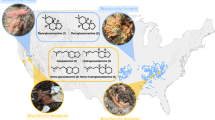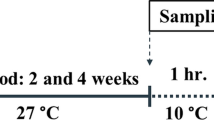Abstract
Fish skin and its corresponding mucus are important defenses against infections from pathogenic organisms, and several types of defensive molecules, particularly lectins, are often found in mucus. Freshwater eels of the genus Anguilla are widely distributed throughout the world, and the genus currently contains 16 species plus 3 subspecies. In this work, genomic sequences of skin mucus C-type lectin-encoding genes from all 19 presently known species/subspecies of the genus Anguilla were determined. The nucleotide sequences were approximately 2 kbp long, and the genomic structure of five exons and four introns was common in all species. All of the encoded C-type lectins were considered functional because of the presence of calcium ion-binding and sugar-binding motifs as well as conserved cysteine residues. Phylogenetic analysis of the genus indicated that the C-type lectins in freshwater eels might be divided into two clusters, corresponding to their temperate and tropical growth habitats, suggesting that Anguilla species C-type lectin has evolved to adapt to microflora in each environment. This study is the first to comprehensively describe the immune-related genes in a complete fish genus.




Similar content being viewed by others
References
Ege V (1939) A revision of the genus Anguilla Shaw, a systematic, phylogenetic and geographical study. Dana Rep 16:1–256
Castle PHJ, Williamson GR (1974) The validity of the freshwater eel species Anguilla ancestralis Ege from Celebes. Copeia 1974:569–570
Watanabe S, Aoyama J, Tsukamoto K (2009) A new species of freshwater eel Anguilla luzonensis (Teleostei: Anguillidae) from Luzon Island of the Philippines. Fish Sci 75:387–392
Aoyama J (2009) Life history and evolution of migration in catadromous eels (genus Anguilla). Aqua BioSci Monogr 2:1–42
Aoyama J, Watanabe S, Miller MJ, Mochioka N, Otake T, Yoshinaga T, Tsukamoto K (2014) Spawning sites of the Japanese eel in relation to oceanographic structure and the West Mariana Ridge. PLoS One. doi:10.1371/journal.pone.0088759
Schmidt J (1922) The breeding places of the eel. Philos Trans R Soc Lond B 211:179–208
Tesch FW (1977) The eel. Chapman and Hall Ltd, London
Tsukamoto K (1992) Discovery of the spawning area for Japanese eel. Nature 356:789–791
Tsukamoto K (2006) Spawning of eels near a seamount: tiny transparent larvae of the Japanese eel collected in the open ocean reveal a strategic spawning site. Nature 493:929
Tsukamoto K, Chow S, Otake T, Kurogi H, Mochioka N, Miller MJ, Aoyama J, Kimura S, Watanabe S, Yoshinaga T, Shinoda A, Kuroki M, Oya M, Watanabe T, Hata K, Ijiri S, Kazeto Y, Nomura K, Tanaka H (2011) Oceanic spawning ecology of freshwater eels in the western North Pacific. Nat Commun 2:179. doi:10.1038/ncomms1174
Alexander JB, Ingram GA (1992) Noncellular nonspecific defense mechanisms of fish. Ann Rev Fish Dis 2:249–279
Ingram GA (1980) Substances involved in the natural resistance of fish to infection—a review. J Fish Biol 16:23–60
Suzuki Y, Tasumi S, Tsutsui S, Okamoto M, Suetake H (2003) Molecular diversity of skin mucus lectins in fish. Comp Biochem Physiol 136B:723–730
Barondes SH (1988) Bifunctional properties of lectins; lectin redefined. Trends Biochem Sci 13:480–482
Sharon N, Lis H (1972) Lectins: cell-agglutinating and sugar-specific proteins. Science 177:949–959
Tasumi S, Ohira T, Kawazoe I, Suetake H, Suzuki Y, Aida K (2002) Primary structure and characteristics of a lectin from skin mucus of the Japanese eel Anguilla japonica. J Biol Chem 277:27305–27311
Tasumi S, Yang WJ, Usami T, Tsutsui S, Ohira T, Kawazoe I, Wilder MN, Aida K, Suzuki Y (2004) Characteristics and primary structure of a galectin in the skin mucus of the Japanese eel, Anguilla japonica. Dev Comp Immunol 28:325–335
Aoyama J, Nishida M, Tsukamoto K (2001) Molecular phylogeny and evolution of the freshwater eel, genus Anguilla. Mol Phylogenet Evol 20:450–459
Minegishi Y, Aoyama J, Inoue JG, Miya M, Nishida M, Tsukamoto K (2005) Molecular phylogeny and evolution of the freshwater eels genus Anguilla based on the whole mitochondrial genome sequences. Mol Phylogenet Evol 34:134–146
Tanaka C, Shirotori F, Sato M, Ishikawa M, Shinoda A, Aoyama J, Yoshinaga T (2014) Genetic identification method for two subspecies of the Indonesian short-finned eel, Anguilla bicolor, using an allelic discrimination technique. Zool Stud 53:57. doi:10.1186/s40555-014-0057-8
Yoshinaga T, Aoyama J, Shinoda A, Watanabe S, Azanza RV, Tsukamoto K (2014) Occurrence and biological characteristics of glass eels of the Japanese eel Anguilla japonica at the Cagayan River of Luzon Island, Philippines in 2009. Zool Stud 53:13. doi:10.1186/1810-522X-53-13
Tsutsui S, Iwamoto K, Nakamura O, Watanabe T (2007) Yeast-binding C-type lectin with opsonic activity from conger eel (Conger myriaster) skin mucus. Mol Immunol 44:691–702
Breathnach R, Chambon P (1981) Organization and expression of eukaryotic split genes coding for proteins. Annu Rev Biochem 50:349–383
Seif I, Khoury G, Dhar R (1979) BKV splice sequences based on analysis of preferred donor and acceptor sites. Nucleic Acids Res 6:3387–3398
Drickamer K (1988) Two distinct classes of carbohydrate-recognition domains in animal lectins. J Biol Chem 263:9557–9560
Drickamer K (1993) Ca2+-dependent carbohydrate-recognition domain in animal lectins. Curr Opin Struct Biol 3:393–400
Drickamer K (1993) Evolution of Ca2+-dependent animal lectins. Prog Nucl Acid Res Mol Biol 45:207–232
Weis WI, Drickamer K, Hendrickson WA (1992) Structure of a C-type mannose-binding protein complexed with an oligosaccharide. Nature 360:127–134
Tsukamoto K, Watanabe S, Kuroki M, Aoyama J, Miller MJ (2014) Freshwater habitat use by a moray eel species, Gymnothorax polyuranodon, in Fiji shown by otolith microchemistry. Environ Biol Fish 97:1377–1385
Teng HY, Lin YS, Tzeng CS (2009) A new Anguilla species and reanalysis of the phylogeny of freshwater eels. Zool Stud 48:808–822
Lin YS, Poh YP, Tzeng CS (2001) A phylogeny of freshwater eels inferred from mitochondrial genomes. Mol Phylogenet Evol 20:252–261
Inoue JG, Miya M, Miller MJ, Sado T, Hanel R, Hatooka K, Aoyama J, Minegishi Y, Nishida M, Tsukamoto K (2010) Deep-ocean origin of the freshwater eels. Biol Lett 6:363–366
Author information
Authors and Affiliations
Corresponding author
Additional information
Nucleotide sequence data will be available in the DDBJ/EMBL/GenBank databases under the accession numbers LC049084–LC049102.
Rights and permissions
About this article
Cite this article
Tsutsui, S., Yoshinaga, T., Watanabe, S. et al. Skin mucus C-type lectin genes from all 19 Anguilla species/subspecies. Fish Sci 81, 1043–1051 (2015). https://doi.org/10.1007/s12562-015-0922-3
Received:
Accepted:
Published:
Issue Date:
DOI: https://doi.org/10.1007/s12562-015-0922-3




